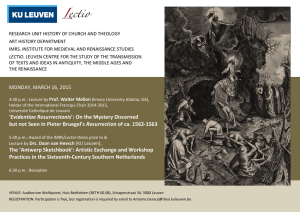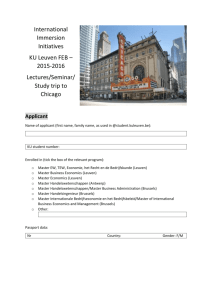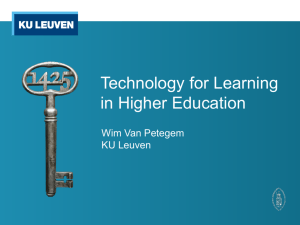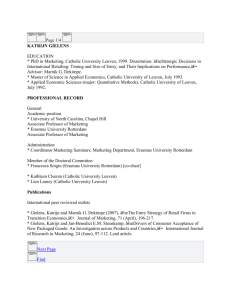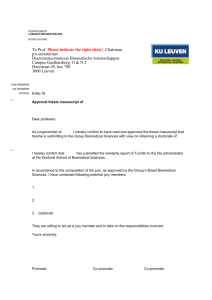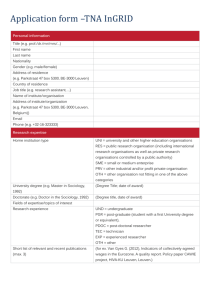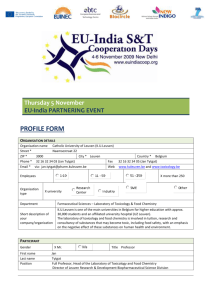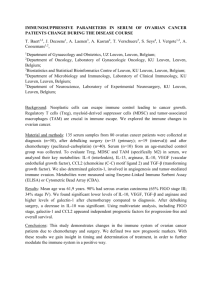Presentation - Slag Valorisation Symposium
advertisement
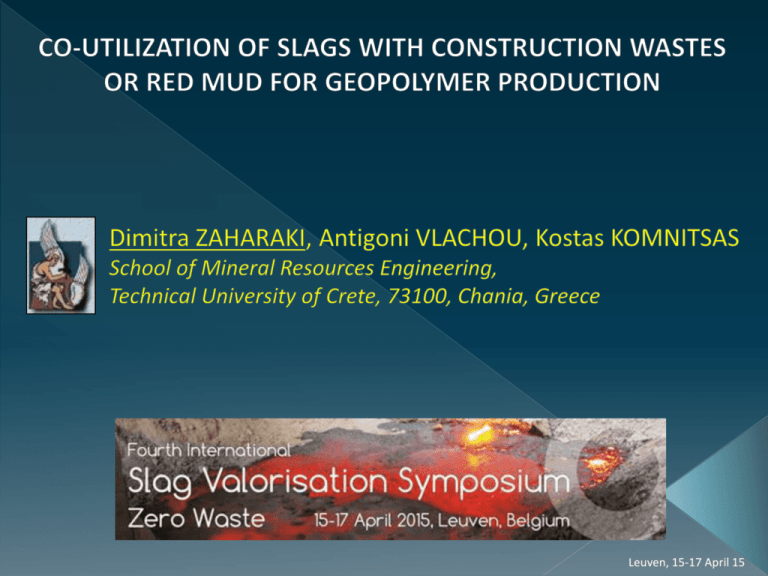
Leuven, 15-17 April 15 Investigation of the co-geopolymerization potential of ferronickel slags with construction/demolition wastes or red mud Contents • Geopolymerization • Materials and experimental methodology • Compressive strength of geopolymers • XRD and FTIR analyses • Conclusions 2 Leuven, 15-17 April 15 • Geopolymers are inorganic materials formed by the alkali activation of aluminosilicates at relatively low temperatures • Partially or fully amorphous polymeric structures consisting of Si-O-Al bonds • The tetrahedral AlO4 and SiO4 units are built in three dimensional structures 3 Leuven, 15-17 April 15 • The structure and mechanical properties of geopolymers are affected by several parameters such as chemical composition and particle size of the raw materials • Various wastes such as fly ash and slag have been extensively investigated as potential raw materials for the synthesis of geopolymers • Geopolymerisation of other wastes and especially construction and demolition wastes (CDW) still remains a great challenge Raw materials Activating solution [aluminosilicate materials or industrial by-products] [ΚΟΗ or ΝaOH and Na2SiO3] 4 Leuven, 15-17 April 15 • Electric arc furnace slag from the “LARCO S.A” ferronickel plant, Greece • CDW (tiles, bricks and concrete) • Red mud from “Aluminium of Greece” 5 Leuven, 15-17 April 15 • All materials were dried and pulverized using a FRITSCH-BICO pulveriser (slag: <120 μm and d50 12 μm, tiles: <140 μm and d50 14 μm, bricks: <140 μm and d50 6.6 μm, concrete: <190 μm and d50 10 μm, red mud: <76 μm and d50 4 μm) Table 1: Chemical composition (%) of raw materials Material Slag (S) Concrete (C) Bricks (B) Tiles (T) Red mud (R) Fe2O3 43.83 0.75 6.00 5.39 41.65 SiO2 36.74 5.81 57.79 70.54 9.28 Al2O3 9.32 1.49 14.95 9.80 15.83 CaO 3.73 65.42 8.79 8.78 10.53 Na2O 0.57 1.03 2.26 K2 O 1.26 2.80 1.37 0.21 MgO 2.76 4.21 4.75 4.46 - TiO2 0.03 0.85 0.77 4.73 LOI 21.59 1.89 16.77 SUM 96.4* 101.1 98.9 101.1 101.3 LOI: Loss on ignition after heating the material at 1050 oC for 4 h, *Cr2O3: 2.82 % 6 Leuven, 15-17 April 15 • The activating solution consists of NaOH or KOH anhydrous pellets, distilled water and sodium silicate solution • Raw materials were then mixed with the activating solution (8-10 M NaOH or KOH) • The specimens produced (5 cm edge) were heated at 80 °C in a laboratory oven for 7 days and then subjected to compressive strength testing using an MTS 1600 load frame • X-ray diffraction (XRD) of the final products using a Bruker D8 Advance diffractometer • Fourier transform infrared spectroscopy (FTIR) on KBr pellets using a Perkin–Elmer Spectrum 1000 spectrometer 7 Leuven, 15-17 April 15 Geopolymers from concrete, bricks and tiles (left to right) Slag-red mud geopolymer Slag-CDW geopolymer 8 Leuven, 15-17 April 15 9 Leuven, 15-17 April 15 70 60 8 M NaOH S 80 °C, 7 d 10 M NaOH T 50 40 B 30 20 10 0 C Compressive strength (MPa) Compressive strength (MPa) 80 80 10 M NaOH 10 M KOH 80 oC, 7 d 70 60 50 40 30 20 10 0 100-0 90-10 80-20 70-30 60-40 50-50 0-100 • Slag-CDW geopolymers prepared with 10 M NaOH acquired higher compressive strength • The percentage of each CDW component in the initial mixture affects the compressive strength at 10 M NaOH • The compressive strength decreases gradually with increasing red mud % Leuven, 15-17 April 15 10 SiO2/Al2O3 7.33 GeopoGeopolymer lymer T B C R 50-10-10-30 25-30-30-15 12.67 6.84 9.86 1.33 8.26 8.86 H2O/(Na2O+K2O) 8.30 9.03 8.32 6.62 8.11 6.96 6.10 6.66 SiO2/(Al2O3+CaO) 4.03 4.81 3.30 0.12 0.60 1.18 2.21 1.70 Strength, MPa 76.1 57.8 39.4 59.2 78.4 38 S 7.8 11 2.5 Geopolymer 50S-50R 3.53 Leuven, 15-17 April 15 12 Leuven, 15-17 April 15 13 Leuven, 15-17 April 15 • Slag can be successfully co-utilized with various byproducts/wastes such as CDW and red mud • Production of geopolymers with compressive strength between 37 and 80 MPa using 10 M NaOH or KOH as alkali activator • The presence of the major fingerprints of the aluminosilicate geopolymeric matrix was revealed by XRD and FTIR analysis 14 Leuven, 15-17 April 15 Technical University of Crete School of Mineral Resources Engineering Research unit “Management of Mining/Metallurgical Wastes and Rehabilitation of Contaminated Soils” http://www.mred.tuc.gr/3020.html Acknowledgements The present study has been co-funded by the European Commission (European Regional Development Fund) and by national funds through the Operational Programme “Competitiveness and Entrepreneurship” (OPCE ΙΙ 2007 - 2013), National Strategic Reference Framework – Research funded project: “Recycling of quarry dust and construction and demolition wastes for the production of novel ecological building elements”, DURECOBEL 11SYN_8_584, in the framework of the Action COOPERATION 2011– Partnerships of Production and Research Institutions in Focused Research and Technology Sectors. Project website: http://www.durecobel.gr/ 15 Leuven, 15-17 April 15
